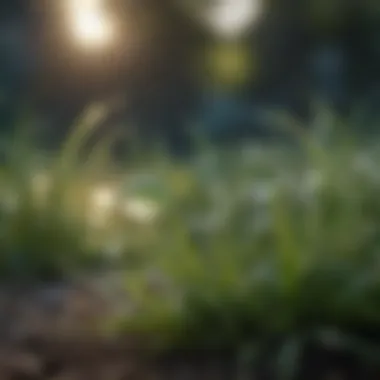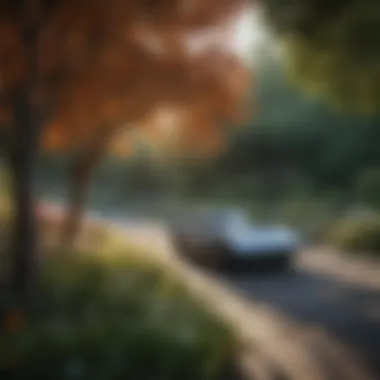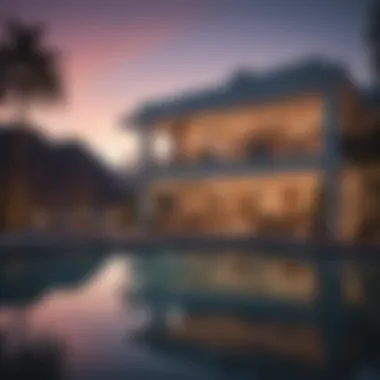Elevating Outdoor Living: A Comprehensive Guide to Color Palettes for Aesthetics


Outdoor Decor Ideas
From selecting the right hues to understanding the psychology of color schemes, the art of creating visually stunning outdoor living spaces is a delicate balance of aesthetics and functionality. As we embark on a journey through the intricate world of color palettes, it becomes clear that each element plays a crucial role in harmonizing the overall ambiance of the outdoor area. Choosing seasonal inspirations, matching furniture, selecting decorative lighting, arranging plants thoughtfully, incorporating hardscaping solutions, and embracing sustainable practices are all integral components in achieving a cohesive and visually captivating outdoor decor.
Seasonal Inspirations
Each season brings with it a unique color palette inspired by nature's changing hues. From the vibrant blooms of spring to the warm earth tones of autumn, incorporating seasonal inspirations into outdoor decor can evoke different moods and emotions. By carefully curating colors that resonate with the time of year, outdoor spaces can be transformed into dynamic expressions of nature's beauty.
Furniture Selection
The choice of furniture is not only about functionality but also about aesthetics. Selecting pieces that complement the color scheme and overall style of the outdoor area is key to creating a cohesive look. Whether opting for modern minimalist designs or classic, timeless pieces, the furniture selection sets the tone for the entire space, influencing how colors are perceived and experienced.
Decorative Lighting
Lighting plays a significant role in accentuating colors and creating ambiance. Selecting the right lighting fixtures can enhance the depth and vibrancy of hues, transforming the outdoor space from day to night. From soft ambient lights that create a cozy atmosphere to statement pieces that serve as art installations, decorative lighting brings another dimension to the color palette, adding layers of visual interest.
Plant Arrangements
Plants not only add a touch of greenery but also contribute to the color scheme of outdoor decor. Thoughtfully arranging plants based on their colors, sizes, and textures can create a harmonious balance within the space. Whether opting for a lush, tropical oasis or a sleek, modern garden, plant arrangements play a vital role in defining the overall color palette and aesthetic appeal.
Hardscaping Solutions
Incorporating hardscaping elements such as stone pathways, wooden decks, or pergolas can introduce new textures and tones to the outdoor area. Hardscaping solutions not only provide functional elements like walkways and seating areas but also serve as design features that complement the color palette. By integrating hardscaping with softscaping elements like plants and flowers, a cohesive outdoor decor is achieved.
Sustainable Practices
Embracing sustainable practices in outdoor decor goes beyond just choosing eco-friendly materials. It involves incorporating nature-inspired color palettes, utilizing energy-efficient lighting, and promoting green spaces that benefit the environment. By integrating sustainable practices into the design process, outdoor living spaces can become not only visually appealing but also environmentally conscious, aligning with the beauty of nature's color palette.


Introduction to Color Palette
In this section, we embark on a profound journey into the essence of the color palette within the realm of outdoor living aesthetics. Understanding the pivotal role that colors play in shaping our environments is paramount. Delving into the complexities of hues and tones, we unravel the fabric of visual appeal knit by the selection of colors. The importance of the color palette cannot be overstated, as it serves as the foundational canvas upon which outdoor spaces are transformed into enchanting havens for relaxation and rejuvenation. By dissecting the implications of various color schemes and combinations, we pave the way for a meticulous exploration of aesthetic enhancement in outdoor settings - a domain where every shade holds significance.
Understanding Color Theory
The Basics of Color Wheel
Exploring the fundamentals of the color wheel is akin to deciphering the universal language of colors. By breaking down the primary, secondary, and tertiary hues, we unlock a treasure trove of possibilities for orchestrating captivating outdoor visual experiences. The color wheel stands as a testament to the interconnectedness of hues, showcasing the delicate balance between warm and cool tones. Its structured organization provides a roadmap for crafting harmonious color palettes that evoke a myriad of emotions and perceptions. In this light, the color wheel emerges as a beacon of creativity, guiding designers towards a symphony of colors that captivate the senses and elevate outdoor aesthetics.
Impact of Different Colors
The significance of different colors extends far beyond mere visual appeal; each hue possesses the power to elicit distinct psychological responses. From the tranquil blues that instill a sense of calm to the vibrant reds that evoke passion and energy, colors wield a profound influence on our emotions and moods. Understanding the impact of varied hues on human psychology is crucial in the realm of outdoor design, where the manipulation of color can shape the ambiance and atmosphere of a space. By delving deep into the psychological underpinnings of colors, designers can craft outdoor environments that resonate with individuals on a subconscious level, creating immersive experiences that transcend mere aesthetics.
Color Psychology in Outdoor Design
Emotional Responses to Colors
Color psychology delves into the intricate relationship between hues and human emotions, unveiling the profound impact that colors wield on our mental states. Each color harbors a unique emotional resonance, from the serene greens that evoke tranquility to the passionate reds that spark vitality. By understanding the emotional responses elicited by different hues, designers can curate outdoor spaces that evoke specific feelings and moods, catering to individual preferences and desires. This nuanced approach to color selection adds layers of meaning and depth to outdoor design, transforming mere spaces into immersive environments that resonate with the human psyche.
Creating Desired Ambiance
The creation of a desired ambiance within outdoor settings hinges upon the adept manipulation of color to convey specific moods and atmospheres. Colors serve as the silent narrators of a space, conveying stories of serenity, joy, or sophistication through their chromatic expressions. By strategically selecting hues that align with the intended ambiance, designers can curate outdoor environments that evoke the desired emotional responses from occupants. Whether aiming for a relaxing retreat infused with pastel tones or a vibrant social space punctuated by bold accents, the art of creating ambiance through color selection lies at the heart of outdoor design excellence.
Selecting the Perfect Palette
In this section, we delve into the crux of choosing a perfect color palette for outdoor spaces. Selecting the right colors is crucial to achieving visual harmony and enhancing the aesthetics of the environment. The perfect palette sets the tone for the entire design, influencing mood and perception. By understanding the impact of colors on outdoor areas, one can create a captivating ambiance that resonates with the surroundings and fulfills the desired aesthetic vision. Considerations such as natural lighting, existing decor elements, and personal preferences play a significant role in selecting the perfect palette, ensuring coherence and elegance in outdoor living spaces.
Harmonious Color Schemes


Analogous, Complementary, and Triadic Colors
Analogous, complementary, and triadic colors are fundamental aspects of creating harmonious color schemes in outdoor design. Analogous colors sit next to each other on the color wheel and provide a sense of cohesion and fluidity in the palette. Complementary colors, found opposite each other on the wheel, offer vibrant contrast and visual interest when combined. Triadic colors, evenly spaced around the wheel, create dynamic energy and balance in the scheme. Understanding the unique characteristics of each color scheme allows for strategic utilization in outdoor decor to evoke specific emotions and highlight key design elements, enhancing the overall visual impact.
Creating Visual Balance
Creating visual balance through color is essential in achieving a cohesive and appealing outdoor space. By distributing colors evenly throughout the area, one can ensure a sense of equilibrium and unity. Visual balance involves careful placement of color elements to avoid overwhelming or underwhelming sections of the design. This aspect is crucial in creating a harmonious atmosphere that invites relaxation and enjoyment. Maintaining visual balance in the color scheme ensures that every part of the outdoor setting contributes seamlessly to the overall aesthetic, elevating the space to a luxurious and refined level.
Considering Outdoor Elements
Harmonizing with Nature
Harmonizing the color palette with nature is an integral part of outdoor design that celebrates the environment's innate beauty. Choosing colors inspired by the outdoor surroundings creates a seamless transition between the natural landscape and the designed space. By incorporating earthy tones, greens, blues, and organic hues, one can enhance the connection to nature and establish a serene atmosphere. Harmonizing with nature not only enhances the aesthetic appeal of outdoor areas but also promotes a sense of tranquility and well-being, inviting occupants to immerse themselves in the sensory experience of the outdoors.
Integration with Architecture
Integrating the color palette with architectural elements is essential for creating a cohesive outdoor setting that blends seamlessly with the built environment. By aligning the color scheme with the architectural style, materials, and textures, one can enhance the architectural features and create a unified visual language. Integration with architecture ensures that the outdoor space complements the overall design of the property, harmonizing colors to embody a sophisticated and luxurious ambiance. This strategic approach transforms outdoor living areas into extensions of the architectural masterpiece, crafting a holistic and visually captivating outdoor experience.
Implementing Color in Outdoor Decor
In the vast realm of enhancing outdoor spaces, the implementation of color is a pivotal element that can transform a dull area into a vibrant oasis. Incorporating a thoughtfully curated color scheme in outdoor decor can amplify the aesthetic appeal and create a harmonious ambiance for residents and guests alike. By strategically placing hues in furniture, accessories, plants, and landscaping, one can evoke specific emotions and enhance the overall visual experience. The balanced integration of colors not only adds depth to the outdoor setting but also reflects the personal style and creativity of the homeowner or designer, making it a key aspect in the realm of outdoor aesthetics.
Furniture and Accessories
Accent Pieces
Accent pieces play a crucial role in the realm of outdoor decor, acting as focal points that draw attention and add personality to the space. These decorative elements serve as unique statements that reflect the individuality of the design scheme. By incorporating accent pieces such as sculptures, vases, or decorative lighting, one can inject bursts of color and texture into the outdoor environment. The strategic placement of these elements can create visual interest and elevate the overall aesthetic appeal of the space.
Textiles and Cushions


Textiles and cushions are functional yet stylish elements that contribute significantly to the comfort and visual allure of outdoor living areas. Utilizing textiles such as throw blankets, pillows, and outdoor rugs can introduce a touch of luxury and warmth to the setting. The choice of fabrics and patterns adds depth and dimension to the outdoor space, while also allowing for personalization and seasonal variations. Textiles and cushions not only enhance the visual appeal of outdoor furniture but also provide comfort and coziness for individuals relaxing in the space.
Plant Selection and Landscaping
Foliage Colors
The selection of foliage colors in outdoor landscaping plays a vital role in creating a cohesive and visually appealing environment. By choosing plant varieties with a diverse range of leaf colors, from lush greens to vibrant reds and yellows, one can add a dynamic dimension to the outdoor space. Foliage colors not only complement the overall color palette of the outdoor decor but also introduce a natural element that enhances the connection between the space and the surrounding landscape.
Blooming Seasons
Understanding the blooming seasons of plants is essential for maintaining year-round visual interest in outdoor landscaping. By selecting a variety of plants that bloom at different times throughout the year, one can ensure a continuous display of color and texture in the outdoor space. From early spring blossoms to late summer blooms, incorporating a mix of flowering plants adds a seasonal rhythm to the landscape, creating ever-changing vistas that evolve with the passage of time.
Maintaining Consistency and Flow
Maintaining Consistency and Flow in outdoor living spaces is crucial for creating a cohesive and aesthetically pleasing environment. By ensuring that colors, textures, and design elements flow seamlessly from one area to another, you can enhance the overall visual impact of the space. Consistency in color palettes throughout different outdoor zones fosters a sense of harmony and unity, making the space feel more connected and inviting to both residents and guests. Flowing transitions between spaces can guide the eye smoothly from one area to another, creating a sense of continuity and balance.
Transitions Between Spaces
Creating Cohesive Transitions
Creating Cohesive Transitions plays a pivotal role in bridging the gap between distinct outdoor areas. By utilizing similar color schemes, materials, or design elements, cohesive transitions help in establishing a visual link between spaces. The key characteristic of Creating Cohesive Transitions is its ability to unify disparate elements into a cohesive whole, providing a seamless flow from one area to the next. This strategy is beneficial for creating a harmonious and visually appealing outdoor environment, where every section complements the overall aesthetic. Despite some minor imperfection in implementation, Creating Cohesive Transitions remains a popular choice due to its effectiveness in creating a sense of continuity.
Seamless Integration
Seamless Integration focuses on blending different elements in outdoor spaces effortlessly. This approach emphasizes consistency in design, materials, and color choices to maintain a unified look throughout the area. The key characteristic of Seamless Integration lies in its ability to merge diverse components seamlessly, creating a polished and sophisticated outdoor setting. It is a popular choice due to its capacity to create a cohesive appearance while allowing individual elements to shine. Despite the challenges it may pose during execution, Seamless Integration offers the advantage of presenting a cohesive and well-coordinated outdoor space.
Visual Impact and Durability
Longevity of Color Choices
Longevity of Color Choices is a significant consideration in outdoor design as it influences the overall look and feel of the space over time. Selecting colors that are timeless and resistant to trends ensures that the outdoor decor remains stylish and relevant for years to come. The key characteristic of Longevity of Color Choices is its ability to withstand changing design preferences, providing a timeless appeal to the outdoor living area. This aspect is beneficial for creating a lasting impression and maintaining the visual integrity of the space. Though it may require meticulous planning and consideration during the selection process, the longevity of color choices adds a sense of timeless elegance to outdoor design.
Weather Resistance
Weather Resistance is essential for outdoor elements to withstand various weather conditions and maintain their visual appeal and functionality. Choosing materials and finishes that can endure exposure to sun, rain, and other elements ensures longevity and durability of outdoor decor. The key characteristic of Weather Resistance is its ability to protect outdoor furniture, accessories, and structures from environmental damage, preserving their beauty and structural integrity. Despite the need for periodic maintenance and care, weather-resistant features contribute significantly to the long-term sustainability of outdoor design, making it a practical and essential consideration.







